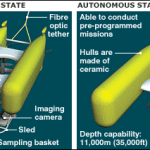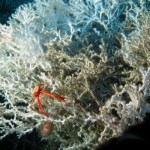In the words of Rick at MBSL&S
So let’s just say you have a couple hundred thousand metric tons of iron filings laying around the house. While in the tub one day, you conceive of a terrific idea of dumping all that iron into the ocean, thus seeding phytoplankton growth (iron is a limiting nutrient for phytoplankton) and sequestering atmospheric carbon for centuries deep underwater. Voila! Hello carbon sink… goodbye global warming. And even better, you can sell shares of your iron filing dumping as carbon offsets to individuals and business who are looking to feel more carbon neutral. It’s a win-win deal!
As you might guess he is skeptical…and frankly I am with him. Rick discusses Climos that proposes a code of conduct to address contentious aspects of how such experiments are conducted.
The 2-page document calls on anyone doing experiments to protect the marine environment by obtaining permits from relevant authorities, do full environmental assessments, and avoid sensitive ecosystems. It calls for openness through release of data, third party verification of carbon uptake, and collaboration with the broader scientific community.
The key company that wants to dump iron all over the oceans? Planktos.
Indeed, they are investing 2 million to dump 100 tons of pulverized iron this November for the first time. The money quote
“We think of ourselves as an ecological restoration company, and the end results of our company will be beneficial in lots of different ways — including economic ways,” said Bill Coleman, Planktos’ COO and head of marketing.
But as you might expect not all is well. Rick mentions that Friends of the Earth, WWF, ETC Group, Greenpeace, and several Galapagos-based conservation groups (among others) have raised numerous concerns. Moreover John Cullen, oceanographer and phytoplankton researcher, notes
“There was no scientific consensus of what the effects of widespread fertilization would be. It’s been possible to qualify what happened during the course of the experiments, but none of the experiments have been able to quantify the long-term and downstream effects”… “The proposal is to fundamentally alter the chemistry and biology of the ocean on a grand scale. You have to be able to measure those effects and verify them, and be able to say that other, counteracting effects did not occur. They have to be able to quantify secondary effects for 100 years, and there’s no way that can be scientifically verified.”
Planktos disagrees saying that they are doing “the world a favor” by increasing plankton production which is “in a decline”. AND “there’s nothing unnatural about adding an ingredient that has gone missing from the oceans’ natural processes.” But potential problems could be
- Lack of ability to quantify the long-term and downstream effects
- Potential anoxic or hypoxic conditions of the seafloor below fertilization
- Enhanced release of nitrous oxide with 200x the greenhouse gas potential of CO2 during the decomposition of organisms.
- Lack of predictability of the amount carbon dioxide that will actually sink to the seafloor and how long it will be sequestered there.
- Potential of iron filing supply to be contaminated. via Rick
- Potential for harmful algal blooms.via Rick






My microbiology and chemistry are a bit rusty, but I seem to remember that iron (and most metals) are antimicrobial. And wouldn’t the iron rust and suck oxygen out of the water?
Iron is a necessary metal for pretty much all living things, since a lot of enzymes require it to function. In the open ocean, iron is also the limiting nutrient. They’re probably adding some form of iron oxide — pure iron filings don’t remain so for very long.
Let me amend that: In significant areas of the surface of the ocean, iron is the limiting nutrient. In one case I (admittedly vaguely) recall, primary productivity in parts of the south Pacific is almost entirely dependent on iron delivered by sand carried by the wind.
There are, of course, many areas where this is not true. And stimulating a plankton bloom is a very heavy handed way to get a carbon source. You don’t see anyone proposing to dump more phosphate into freshwater systems.
The worst easily-predictable problem is the oxygen-deprivation you mention. Depending on where the blooms end up happening, this could make the dead zone that the Mississippi creates in the Gulf look small.
The planktos website mentions the oxygen problem in one of the news articles they quote, and they mention that they would have to fertilize an area the size of Asia and they’re not sure what would happen with the dead plankton–since they only sequester carbon if they sink to the bottom of the ocean without decomposing….
From: http://www.planktos.com/Science/IronversustheGreenhouse.html
Meh.
Their most recent (undated) piece still doesn’t really answer the carbon flux (what they really want to know) question, and doesn’t touch on the oxygen question.
Meh.
Their entire concept is wrong – there is nothing unnatural about iron limitation in certain areas of the ocean, no more than macronutrient limitation is unnatural around coral reefs. And “ecological restoration company” my patooty. Their “baseline” to which they hope to restore plankton levels is completely arbitrary, since there is no solid evidence than pelagic phytoplankton is depleted. Double meh.
This is my favorite aspect, they have god (the Pope) on their side…
http://www.planktos.com/Newsroom/VaticanbecomesWorldsFirstCarbonNeutralSovereignState.html
I remember reading somewhere — can’t remember where — that this had been tried before and that up to 90% of the iron dumped was simply lost in the depths, since it could not be used by the plankton ‘as is’.
The end results were qualified (by European researchers, if I remember well) as only ‘temporary’ and ‘very limited in scope’. So there.
This seems to me like the most idiotic, hare-brained scheme known to man. It occurs to me (a marine ecology interested layperson) that our oceans have enough to do coping with the rubbish that is poured into them by human “endeavour” without having more stuff dumped into them by lunatics who won’t be around in 100 years time to see what the long term effects of their activities have been. Stop these people, for goodness sake! Call out the army, navy and airforce, the United Nations and whoever else, but stop them!
On the bright side, at least they’re not trying to sell this idea based on restoring depleted pelagic fish stocks (e.g., bluefin tuna)… dammit, I just gave them an idea.
I remember talking about this in a biological oceanography class and it seemed like a good idea at first, but subsequent studies showed that without even addressing the LONG-term impacts, the SHORT-term impacts on carbon flux were negligible. The initial studies had only looked at the immediate primary production and drawdown of carbon at the surface, which definitely occurred, but they ignored the huge boost in secondary production and respiration that released the vast majority of the carbon right back into the water, albeit 20 meters below the surface. I don’t remember the exact depths the carbon made it to, but it was much closer to 20m than the bottom of the ocean, and so it all ended up back in the atmosphere but outside of the physical range of the instruments that were measuring the immediate surface carbon flux… Am I remembering all this correctly?
Max,
You are exactly right. The best estimate for the amount of carbon that makes it to the deep seafloor, and thus potentially sequestered away would be about 5%.
Well if they were going to deposit iron filings, then that is metallic iron and not in a form immediately usable. These would likely just rust away on the ocean floor, not without some impact to the ocean floor. So, I am thinking that if they are serious about affecting phytoplankton bloom, them they must be planning on using some bioavailable form of iron. I think the concern is how iron much to seed, and how far away from coastal zones as one of the effects of this will likely be the blooming of some red algae also. So, if there is some measurable fish kill from red algae… what would the end effect be?